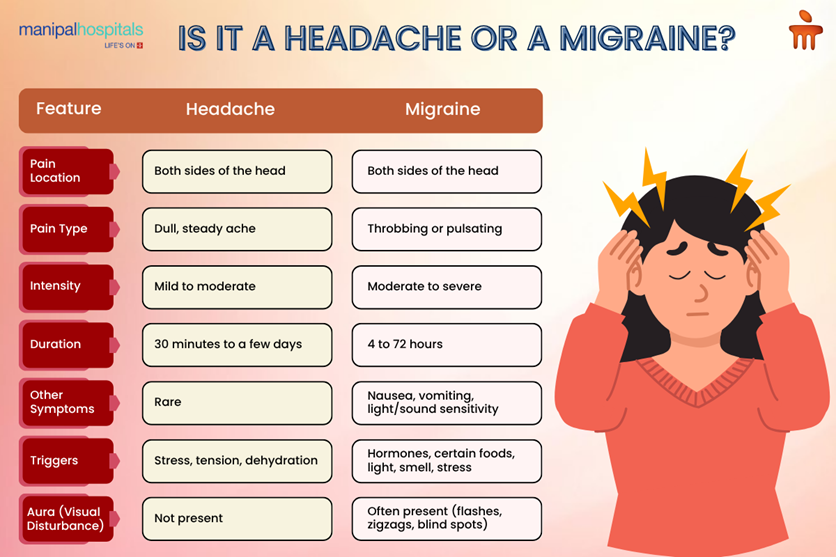
Headaches and migraines are widespread neurological ailments that affect millions of people around the world. While both involve headache pain, their mechanisms, symptoms, and treatments differ significantly. Knowledge about the difference between headaches and migraines is essential for proper treatment and prevention. A top neurologist in Doddaballapur, Bangalore, explains the causes, symptoms and remedies of headaches and migraines.
Synopsis
Understanding the Difference Between Headache and Migraine
There are two kinds of headaches: migraines and regular headaches. Both cause discomfort but are triggered differently and differ in intensity and duration. Migraines tend to be more serious and are commonly accompanied by other effects such as vomiting and sensitivity to light.
Knowing these differences will help you understand which treatment to apply:
-
Tension Headaches: They are the most prevalent form, usually resulting from stress, muscle tension, or poor posture. They produce a dull, aching pain on both sides of the head, lasting from 30 minutes up to several days.
-
Cluster Headaches: These are strong, burning headaches occurring in cycles, each side of the head being affected once at a time. They are accompanied by eye-watering, nasal congestion, and facial sweating.
-
Sinus Headaches: These occur when the sinus cavities become inflamed or infected, causing pain around the eyes, forehead, and cheekbones. They usually get worse with head movements.
-
Migraine Headaches: Unlike regular headaches, migraines are severe and throbbing and usually localised to one side of the head. They may last for hours or even days and are accompanied by nausea, vomiting, and extreme light (or sun) or sound sensitivity.
-
Cervicogenic Headaches: These begin in the neck and extend up to the head, frequently due to poor posture, a neck injury or disease of the cervical spine.
-
Rebound Headaches: These occur due to overuse of pain medications and can create a cycle of dependency, making the headaches more frequent.
-
Hormonal Headaches: Common in women, these are linked to hormonal changes during menstruation, pregnancy, or menopause.
Symptoms of Headache vs. Migraine - Key Differences
While both headaches and migraines cause pain, migraine symptoms are usually more severe and can disrupt daily life. Knowing the signs can help you distinguish between the two.

-
Location of Pain: Headaches typically cause pain on both sides of the head, while migraines often cause throbbing pain on one side.
-
Intensity: Migraine symptoms are usually more intense, with a pounding or throbbing sensation, while headaches are often described as a dull ache.
-
Duration: Tension headaches can last from a few hours to a few days, while migraines can persist for up to 72 hours without proper treatment.
-
Accompanying Symptoms: Migraines often come with nausea, vomiting, and sensitivity to light or sound, while regular headaches usually lack these symptoms.
-
Triggers: Common migraine triggers include hormonal changes, stress, certain foods, and environmental factors, while headaches are often triggered by muscle tension or dehydration.
-
Aura: Many migraine sufferers experience auras – visual disturbances like flashing lights, blind spots, or zigzag patterns – before the pain starts.
Is Migraine Dangerous? Understanding the Risks
Many people wonder, "Is migraine dangerous?" While not usually life-threatening, untreated or severe migraines can have serious health consequences.
-
Risk of Stroke: Research suggests that people with migraines, especially with aura, have a slightly higher risk of stroke.
-
Cardiovascular Disease: Studies indicate a potential link between migraines and an increased risk of heart disease and heart attacks.
-
Mental Health Issues: Chronic migraines can lead to anxiety, depression, and reduced quality of life due to the constant fear of attacks.
-
Medication Overuse: Frequent use of painkillers for migraine relief can lead to rebound headaches and long-term dependency.
-
Neurological Complications: In rare cases, severe migraines can cause complications like persistent aura without infarction or migraine-induced seizures.
-
Vision Problems: Prolonged migraine auras can temporarily affect vision, creating blind spots or tunnel vision.
-
Chronic Pain Conditions: Untreated migraines can lead to chronic daily headaches, significantly impacting your quality of life.
Effective Treatments for Headaches and Migraines
Managing headaches and migraines effectively often requires a combination of medication, lifestyle changes, and preventive strategies.
-
Over-the-Counter Pain Relievers: Medications like ibuprofen, aspirin, and acetaminophen can help relieve mild headaches and migraines.
-
Prescription Medications: To reduce the frequency and severity of severe migraines, doctors may prescribe triptans, beta-blockers, or CGRP inhibitors.
-
Physical Therapy: Physical therapy can help reduce muscle tension and prevent headaches caused by poor posture or neck issues.
-
Stress Management: Practices like yoga, meditation, and deep breathing exercises can help reduce the frequency of migraine attacks.
-
Dietary Changes: Avoiding common migraine triggers like caffeine, alcohol, and processed foods can reduce attack frequency.
-
Cold or Warm Compress: Applying a cold pack to the head or a warm compress to the neck can provide immediate relief.
-
Botox Injections: Botox injections can help reduce the number of headache days each month for chronic migraines.
Conclusion
Understanding the difference between headaches and migraines is crucial for proper management and prevention. With the right combination of lifestyle changes, medication, and preventive strategies, headaches and migraines can be effectively managed.
FAQ's
Headaches are usually mild to moderate and cause pressure or aching on both sides of the head. At the same time, migraines are intense, throbbing headaches often accompanied by nausea, light sensitivity, and visual disturbances.
There is no permanent cure for migraines, but they can be effectively managed with lifestyle changes, medication, and preventive strategies.
While not typically life-threatening, untreated migraines can increase the risk of stroke, heart disease, and mental health issues.
Avoid common triggers, maintain a regular sleep schedule, and manage stress. Also, eat a balanced diet to reduce migraine frequency.
Readily manageable migraines may not require specialist consultation. However, you should seek medical advice if you experience frequent or severe migraines that disrupt daily life or if over-the-counter medications are not effective.





















 5 Min Read
5 Min Read










